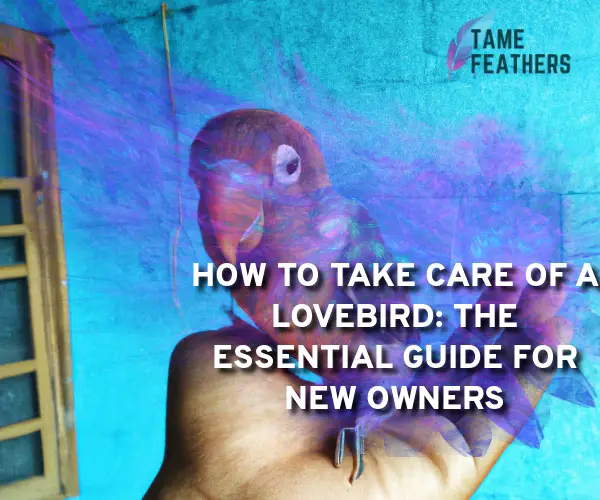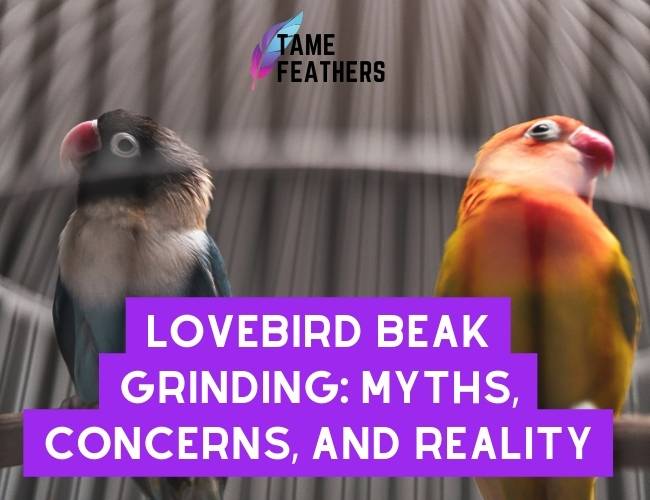Table Of Contents
- Choosing Your Lovebird
- Creating The Ideal Environment For Your Lovebird
- Bonding With Your Lovebirds
- Taking Care Of Health And Wellbeing
- Taming Your Pet Lovebirds
- Socializing With Other Birds & Pets
- FAQs About Lovebirds
- Have You Tried This Gourmet Parrot Food?
- We Thought You Might Want To Know This About Lovebirds… 😊
Choosing Your Lovebird
It is essential to select a lovebird that is in sound physical condition when making your purchase.A bird that is in good health will have bright eyes, feathers that are shiny, and a lively disposition.
It is essential that you complete research on the breed of lovebird that you are interested in getting because different species of lovebirds have varying degrees of tameness.
After you have selected a lovebird, keep in mind that they want company.
Because of this, you should ensure that they are either paired with another lovebird or have someone who can spend time with them on a daily basis.
Creating The Ideal Environment For Your Lovebird
For your pet lovebirds to live in an atmosphere that is both happy and healthy for them, there should be sufficient room for them to fly around freely.The birds receive an adequate amount of stimulation and activity from having a cage that is of a sufficient size and contains perches of varying heights.
You should also make sure there are toys within easy reach inside the cage.
This will promote activity, which will keep your pet from becoming bored too quickly.
In addition to this, ensure that they have a well-balanced diet by regularly supplying them with fresh fruits and vegetables.
Bonding With Your Lovebirds
Lovebirds develop close relationships with their owners over the course of their ownership; nevertheless, it is essential to avoid jumping into interactions with them too fast, as doing so may provoke aggressive behavior from your birds.To begin, create a familiar environment for your birds by speaking gently near their cages and delivering goodies whenever it is possible to do so.
This helps establish a bond between you and your birds right immediately.
As time goes on, you should start handling them gently; during these periods, you should also avoid making unexpected movements or loud noises.
.
Taking Care Of Health And Wellbeing
Check the lovebirds’ wings on a regular basis to ensure that they are in the best possible health; if you notice any feathers that appear to be damaged, take the birds to an avian veterinarian as soon as possible for diagnosis and treatment (if necessary).In addition, give them dust baths once a week; this helps eliminate debris from their feathers, which in turn helps keep their appearance smooth.
Last but not least, ensure that your pet gets a proper amount of sunlight every day, preferably spending several hours outside in direct light if it’s possible (weather permitting).
.
Taming Your Pet Lovebirds
Taming pet birds requires patience and consistency.Begin the process by gradually introducing yourself to the bird through verbal communication.
Talk about anything mundane, but don’t focus attention directly on the bird just yet.
The objective of this phase is familiarization before moving on to physical contact.
When the bird looks to be at ease, you can gradually approach it by extending an open palm that is full with food items (mealworms are an excellent choice).
Keep doing this until you are able to delicately touch the bird’s head without the risk of being bitten.
Socializing With Other Birds & Pets
It is crucial that early socialization with other pets such as cats or dogs occurs, especially at a young age, in order to prevent aggressive behavior from developing into a problem in the future.In order to accomplish this goal, both animals should be introduced to one other one at a time, and then gradually brought together for supervised interactions over the course of several days or weeks, until they are both content living together without conflict.
When you bring new birds into your home, you should exercise extra caution when introducing them to the other members already living there.
You should keep all of the birds in separate cages at first before allowing them to interact with one another.
This will prevent potential fights from breaking out due to conflict resolution issues caused by territorial disputes, for example.





